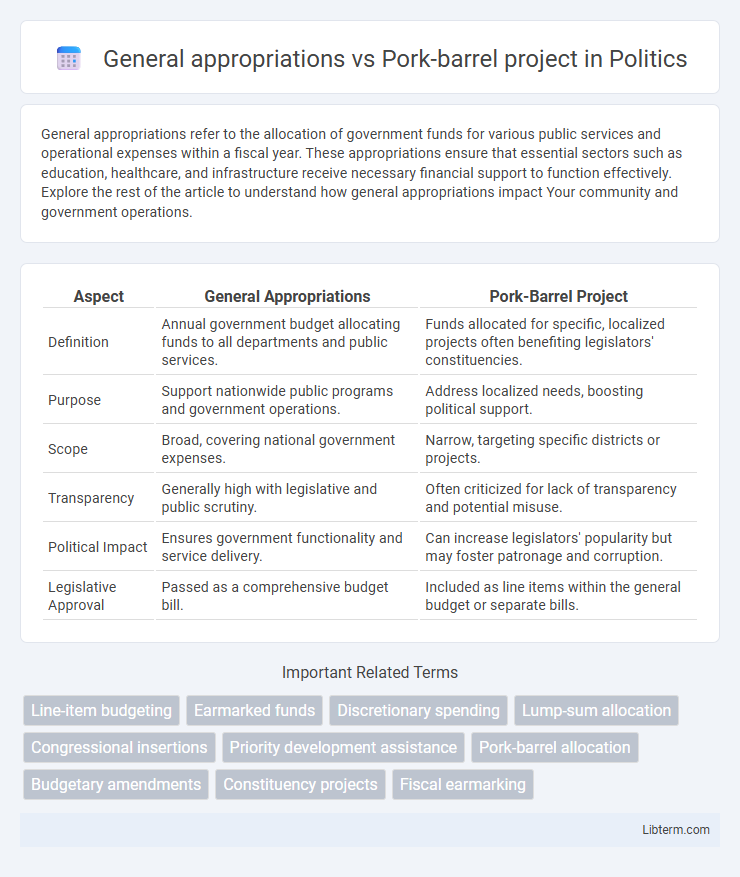General appropriations refer to the allocation of government funds for various public services and operational expenses within a fiscal year. These appropriations ensure that essential sectors such as education, healthcare, and infrastructure receive necessary financial support to function effectively. Explore the rest of the article to understand how general appropriations impact Your community and government operations.
Table of Comparison
| Aspect | General Appropriations | Pork-Barrel Project |
|---|---|---|
| Definition | Annual government budget allocating funds to all departments and public services. | Funds allocated for specific, localized projects often benefiting legislators' constituencies. |
| Purpose | Support nationwide public programs and government operations. | Address localized needs, boosting political support. |
| Scope | Broad, covering national government expenses. | Narrow, targeting specific districts or projects. |
| Transparency | Generally high with legislative and public scrutiny. | Often criticized for lack of transparency and potential misuse. |
| Political Impact | Ensures government functionality and service delivery. | Can increase legislators' popularity but may foster patronage and corruption. |
| Legislative Approval | Passed as a comprehensive budget bill. | Included as line items within the general budget or separate bills. |
Understanding General Appropriations: Definition and Purpose
General appropriations refer to the annual government budget approved by the legislature that allocates funds for broad public services and government operations, ensuring the continuous functioning of agencies and programs nationwide. Its purpose is to provide a comprehensive financial plan that supports essential sectors such as education, healthcare, infrastructure, and public safety. Unlike pork-barrel projects, which target localized or specific interests, general appropriations emphasize equitable distribution and overall national priorities.
What Are Pork-Barrel Projects? Key Features Explained
Pork-barrel projects are localized government expenditures aimed at benefiting specific constituents, often included in general appropriations bills to secure political support. These projects typically involve funding for infrastructure, community facilities, or other localized improvements that may not have broad national significance but hold strategic value for lawmakers' districts. Key features include targeted allocation, political motivation, and the potential for increased government spending beyond general appropriations to address specific local interests.
Historical Context: The Evolution of Government Funding
Government funding evolved from broad general appropriations, which allocate budget resources across multiple departments for overall governance, to include pork-barrel projects aimed at localized benefits to secure political support. Historically, general appropriations reflected centralized fiscal control during early government formations, while pork-barrel spending emerged in the 19th century as legislators sought tangible projects to aid their constituencies. This evolution illustrates the dynamic balance between national priorities and localized political interests shaping public expenditure patterns over time.
Legal Framework: How Appropriations and Pork-Barrel Differ
General appropriations are governed by the annual budget law enacted by the legislature, ensuring transparent allocation of government funds across various sectors as mandated by the General Appropriations Act (GAA). Pork-barrel projects, often characterized by localized, discretionary fund allocations, have faced legal scrutiny and court rulings such as the Philippine Supreme Court's declaration of the Priority Development Assistance Fund (PDAF) as unconstitutional to prevent misuse and corruption. The clear distinction in the legal framework lies in the mandated legislative approval process and transparency for general appropriations versus the discretionary and often non-transparent nature of pork-barrel allocations.
Distribution Process: Allocating Funds in General Appropriations
The distribution process in General Appropriations involves systematic allocation of government funds based on sectoral priorities and approved budgets passed by the legislature. Funds are dispersed proportionally to national agencies, local government units, and public programs, ensuring transparency and adherence to fiscal guidelines. This contrasts with the pork-barrel project process, where allocations are often designated for specific districts and subject to political negotiation.
Identifying Pork-Barrel Projects in National Budgets
General appropriations allocate funds broadly across government departments or programs based on strategic priorities and national development plans. Pork-barrel projects are specific local initiatives funded through discretionary allocations in the national budget, often driven by political motivations rather than assessed public needs. Identifying pork-barrel projects requires analyzing budget line items for projects with localized benefits lacking transparency or alignment with broader policy objectives.
Transparency and Accountability in Public Spending
General appropriations involve allocating government funds through a transparent budget process subject to legislative scrutiny, enhancing accountability in public spending. Pork-barrel projects often lack transparency, as funds are directed to specific local initiatives without comprehensive oversight, increasing risks of misallocation and corruption. Strengthening transparency mechanisms and enforcing strict accountability standards are essential to ensure equitable and efficient use of public resources.
Economic and Social Impacts: General Appropriations vs Pork-Barrel
General appropriations allocate government funds transparently across sectors, promoting balanced economic growth and equitable social services, which enhance public welfare systematically. In contrast, pork-barrel projects often concentrate resources in specific localities for political gain, potentially causing inefficiencies, regional disparities, and misallocation of public funds. These divergent funding approaches significantly influence national development by affecting infrastructure quality, social equity, and long-term economic stability.
Public Perception and Controversies Surrounding Pork-Barrel
Pork-barrel projects often spark public controversy due to perceptions of government wastefulness and favoritism linked to localized funding that benefits specific constituencies rather than the broader public good. General appropriations, by contrast, allocate government funds through comprehensive budget processes intended to address national priorities transparently, minimizing suspicions of misuse. Public trust tends to decline sharply when pork-barrel spending is exposed, as it is frequently associated with corruption, inefficiency, and political patronage.
Reform Solutions: Ensuring Fair and Effective Budget Allocation
Reform solutions for budget allocation emphasize transparency and accountability to distinguish general appropriations from pork-barrel projects, which often divert funds for localized benefits rather than national priorities. Implementing stringent criteria and independent oversight bodies ensures that budget allocations align with evidence-based development goals and public welfare. Enhancing participatory budgeting and real-time monitoring systems promotes equitable distribution of resources and curtails misuse of funds.
General appropriations Infographic

 libterm.com
libterm.com